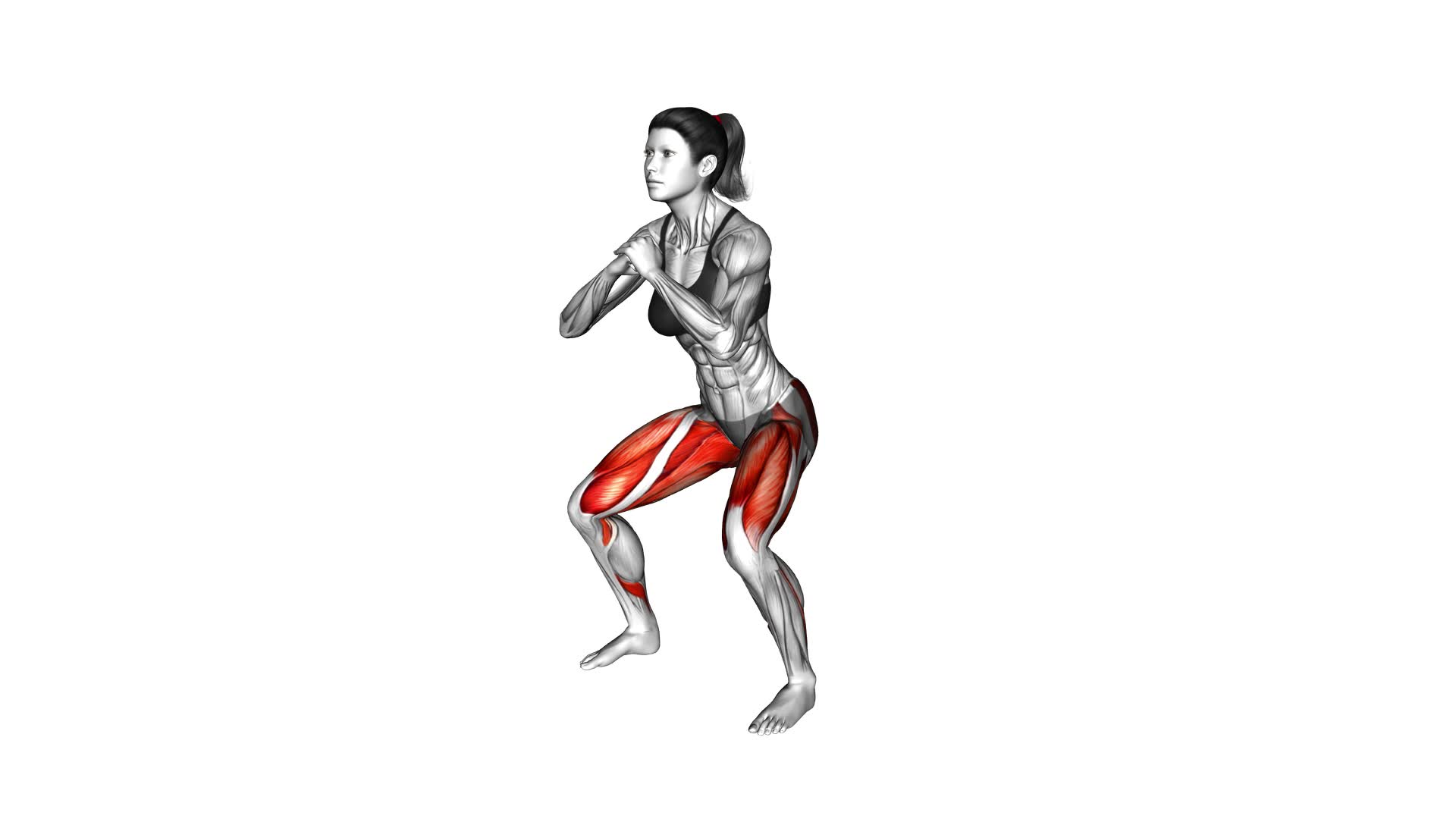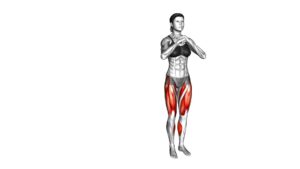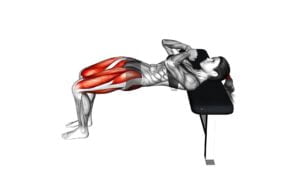Side Step Squat (female) – Video Exercise Guide & Tips

Looking to tone your lower body? Try the side step squat! This video exercise guide and tips will help you perfect your form and get the most out of your workout.
Watch This Exercise Video
With just a few simple modifications, beginners can easily join in. And for those looking for a challenge, we've got advanced variations to take your side step squats to the next level.
Get ready to sculpt your legs and strengthen your core with this effective and efficient exercise. Let's get squatting!
Key Takeaways
- Side step squats are a beneficial exercise for improving lower body strength and stability.
- They target multiple muscle groups including the quadriceps, hamstrings, glutes, and calves.
- Side step squats can be modified to suit different fitness levels and can be done without equipment.
- It is important to maintain proper form and technique, such as avoiding knee collapse and engaging the core and glutes.
Benefits of Side Step Squat
You will experience significant improvements in lower body strength and stability with side step squats. Side step squats are a highly effective exercise that targets your quadriceps, hamstrings, glutes, and calves. By incorporating side step squats into your workout routine, you can enhance your overall lower body strength and stability.
One of the great benefits of side step squats is the variety of variations available. You can perform them with or without weights, using resistance bands, or on an unstable surface like a balance board. These variations allow you to constantly challenge your muscles and prevent plateauing.
To increase the intensity of your side step squats, you can try incorporating different techniques. One way to do this is by adding weights. Holding dumbbells or using a barbell will increase the resistance and make your muscles work harder. Another way to increase intensity is by performing the squats on an unstable surface, such as a Bosu ball. This will engage your core muscles and challenge your balance.
Remember to always maintain proper form while performing side step squats. Keep your chest up, engage your core, and push through your heels as you squat down. Start with a weight and difficulty level that's appropriate for your fitness level and gradually increase as you get stronger.
With consistency and proper technique, side step squats can be a powerful tool in developing lower body strength and stability.
Proper Form and Technique
To ensure proper form and technique while performing the side step squat, there are a few common mistakes you should avoid. These include:
- Allowing your knees to collapse inward
- Not maintaining a neutral spine
- Not engaging your glutes and core
By practicing correct form, you can maximize the benefits of the exercise. These include:
- Strengthening your lower body
- Improving balance
- Enhancing overall stability.
Common Mistakes to Avoid
Avoiding common mistakes is essential for maintaining proper form and technique while performing the Side Step Squat exercise.
One common mistake is allowing the knees to collapse inward during the squat. This puts unnecessary stress on the knees and can lead to injury. To avoid this mistake, make sure to keep your knees in line with your toes throughout the entire movement.
Another common mistake isn't going low enough in the squat. This limits the effectiveness of the exercise and doesn't fully engage the muscles. Make sure to lower your body until your thighs are parallel to the ground.
Lastly, avoid leaning too far forward or backward during the squat. This can strain your back and compromise your form. Keep your torso upright and maintain a neutral spine throughout the exercise.
Benefits of Correct Form
Maintaining proper form and technique during the Side Step Squat exercise offers numerous benefits.
One of the key advantages is the improvement in balance. By engaging the core muscles and focusing on maintaining a stable posture throughout the movement, you enhance your ability to stay steady on your feet. This is particularly beneficial for activities that require balance, such as sports or even everyday tasks like walking on uneven surfaces.
Additionally, correct form ensures optimal muscle activation. By aligning your body correctly and performing the exercise with proper technique, you target the muscles in your legs, glutes, and core more effectively. This leads to increased strength and toning in these areas, helping you achieve your fitness goals faster.
Equipment Needed for Side Step Squat
To perform side step squats effectively, there are a few essential pieces of equipment you'll need.
- First, make sure to have a sturdy pair of athletic shoes that provide proper support and stability.
- Additionally, it's recommended to use a resistance band or dumbbells to add resistance and challenge to the exercise.
- Finally, a comfortable and non-slip exercise mat can help protect your knees and provide a stable surface to perform the squats on.
Essential Equipment for Squats
To perform the Side Step Squat, you'll need the following essential equipment:
- Dumbbells or kettlebells: Adding weight to your squats can increase the intensity and help build strength in your lower body. Start with a weight that challenges you but still allows you to maintain proper form.
- Resistance bands: These bands can be wrapped around your thighs or ankles to provide additional resistance during the side step squat. They help target the muscles in your outer thighs and glutes.
- Exercise mat: A mat can provide cushioning and support for your knees and joints while performing the squats. It also helps prevent slipping on smooth surfaces.
- Stepper or elevated platform: Using a stepper or elevated platform can increase the range of motion and challenge your balance during the side step squat.
These equipment options allow for modifications for beginners who may need to start with lighter weights or use a lower platform to perform the exercise safely and effectively.
Remember to consult with a fitness professional to determine the best equipment options and modifications for your specific needs and goals.
Proper Squatting Gear
What equipment do you need for the Side Step Squat exercise?
When it comes to proper squatting gear, there are a few options to consider.
First and foremost, you'll want to make sure you have a sturdy and comfortable pair of athletic shoes. Look for shoes that provide good support and stability to help you maintain proper form during the exercise.
In addition to shoes, you may also want to consider using a squat pad or barbell pad to cushion your shoulders and upper back. This can help prevent discomfort from the weight of the barbell.
Lastly, it's important to choose the right weight for your side step squats. Start with a weight that challenges you, but allows you to maintain proper form throughout the exercise.
Equipment Options for Squats?
You'll need specific equipment for the Side Step Squat exercise, including a resistance band or dumbbells. Here are some equipment options for squats:
- Resistance band: Using a resistance band adds extra resistance to your squat, helping to strengthen your leg muscles even more.
- Dumbbells: Holding dumbbells in your hands while squatting adds weight and increases the intensity of the exercise.
- Barbell: If you have access to a barbell, you can perform squats by placing it on your shoulders, which allows you to lift heavier weights.
- Kettlebell: Holding a kettlebell in front of your body or goblet-style can challenge your core and upper body while squatting.
However, it's important to note that you can also do squat variations without any equipment. Bodyweight squats are an effective way to build strength and endurance in your legs, especially if you're just starting out or don't have access to equipment.
Modifications for Beginners
If you're new to side step squats, incorporating modifications can help you ease into the exercise and build strength gradually. As a beginner, it's important to start with movements that are manageable for your current fitness level.
One modification you can try is performing the side step squat without any weights. This will allow you to focus on your form and get comfortable with the movement pattern. As you become more comfortable, you can gradually add weights by holding dumbbells or using a resistance band around your thighs for added resistance.
Another modification for beginners is to decrease the range of motion. Instead of squatting down as low as possible, you can start by squatting to a chair or bench. This will help you maintain proper form and prevent any strain on your knees or lower back. As you gain strength and flexibility, you can gradually increase the depth of your squat.
Remember, the key is to start with modifications that challenge you but are still doable. As you progress and feel more confident, you can gradually increase the difficulty of the exercise.
In the next section, we'll explore some advanced variations of the side step squat to take your workout to the next level.
Advanced Variations of Side Step Squat
To challenge yourself further and enhance the effectiveness of your workout, try incorporating advanced variations of the side step squat. These advanced modifications will take your squat routine to the next level, helping you maximize your results.
Here are four variations to consider:
- Weighted Side Step Squat: Hold a dumbbell or kettlebell in each hand while performing the side step squat. This added resistance will engage your muscles even more, increasing the intensity of the exercise.
- Jumping Side Step Squat: Instead of stepping from side to side, explode into a jump after each squat. This plyometric variation won't only work your lower body muscles but also improve your power and explosiveness.
- Single-Leg Side Step Squat: Elevate one leg off the ground while performing the side step squat. This modification will challenge your balance and stability, while also targeting your glutes and quads more intensely.
- Side Step Squat with Resistance Bands: Place a resistance band around your thighs and perform the side step squat. The band will provide constant tension, forcing your muscles to work harder throughout the movement.
By incorporating these advanced variations into your side step squat routine, you can push yourself to new limits and achieve greater results.
Now, let's move on to some tips for getting the most out of your workout.
Tips for Getting the Most Out of Your Workout
Maximize your workout's effectiveness by incorporating proper form and focusing on maintaining a steady pace throughout the side step squat. To get the most out of your workout, it's important to optimize your routine and maximize your results.
Here are some tips to help you achieve that:
- Warm up properly: Before starting any exercise, it's crucial to warm up your muscles. This increases blood flow, loosens up your joints, and prepares your body for the workout ahead.
- Engage your core: Throughout the side step squat, remember to engage your core muscles. This not only helps to stabilize your body but also adds an extra level of intensity to the exercise.
- Keep your knees aligned: As you perform the side step squat, make sure to keep your knees aligned with your toes. This helps to prevent any unnecessary strain on your joints and ensures proper form.
- Control your movements: Avoid rushing through the exercise. Instead, focus on maintaining a steady pace and controlling your movements. This allows you to fully engage your muscles and maximize the benefits of the side step squat.
- Listen to your body: Pay attention to how your body feels during the workout. If you experience any pain or discomfort, make adjustments as needed. It's important to prioritize safety and avoid pushing yourself beyond your limits.
Frequently Asked Questions
How Many Calories Can I Expect to Burn by Doing Side Step Squats?
You can expect to burn a significant amount of calories by doing side step squats. This exercise engages multiple muscle groups, including your glutes, quads, and hamstrings, which increases your overall calorie burn.
The more intense and dynamic your movements are, the more calories you'll likely burn. Additionally, side step squats can increase muscle activation, helping to tone and strengthen your lower body.
Incorporating this exercise into your workout routine can contribute to your overall calorie burning and fitness goals.
Can Side Step Squats Help to Improve My Balance and Coordination?
Yes, side step squats can definitely help improve your balance and coordination. By engaging multiple muscle groups and requiring you to shift your weight from side to side, side step squats can enhance your agility and stability.
Additionally, there are various variations of side step squats that you can incorporate into your routine, such as adding resistance bands or using dumbbells, to further challenge your balance and coordination.
Are Side Step Squats Suitable for Pregnant Women?
Side step squats can be an effective exercise for improving balance and coordination.
However, when it comes to pregnancy, it's important to consider modifications.
Side step squats during pregnancy can still be safe and beneficial, but it's important to listen to your body and make adjustments as needed.
For example, you may need to widen your stance or decrease the depth of the squat to accommodate your growing belly.
Always consult with your healthcare provider before starting any new exercise routine during pregnancy.
Can Side Step Squats Help to Strengthen My Glutes and Thighs?
Side step squats are a great exercise for strengthening your glutes and thighs. By incorporating different variations of side step squats into your workout routine, you can target these muscle groups effectively. These exercises involve stepping to the side while squatting, which engages your glutes and thighs to provide strength and stability.
The benefits of side step squats include improved lower body strength, increased muscle tone, and enhanced balance. Adding them to your fitness routine can help you achieve your goals.
How Often Should I Incorporate Side Step Squats Into My Workout Routine to See Results?
To see results from side step squats, you should incorporate them into your workout routine regularly. Aim to do them at least three times a week. Make sure to also include other lower body exercises to target different muscle groups.
If you're a beginner, start with modifications such as using a resistance band or performing the squats without weights. Gradually increase the intensity and reps as you get stronger. Consistency is key for seeing progress.
Conclusion
In conclusion, the side step squat is a highly effective exercise that targets the lower body muscles, particularly the glutes, quads, and hamstrings. By incorporating this exercise into your workout routine, you can improve your overall strength, stability, and balance.
Remember to maintain proper form and technique throughout the exercise, and feel free to modify or advance the movement based on your fitness level.
With consistency and dedication, you can maximize the benefits of the side step squat and achieve your fitness goals.

Author
Years ago, the spark of my life’s passion ignited in my mind the moment I stepped into the local gym for the first time. The inaugural bead of perspiration, the initial endeavor, the very first surge of endorphins, and a sense of pride that washed over me post-workout marked the beginning of my deep-seated interest in strength sports, fitness, and sports nutrition. This very curiosity blossomed rapidly into a profound fascination, propelling me to earn a Master’s degree in Physical Education from the Academy of Physical Education in Krakow, followed by a Sports Manager diploma from the Jagiellonian University. My journey of growth led me to gain more specialized qualifications, such as being a certified personal trainer with a focus on sports dietetics, a lifeguard, and an instructor for wellness and corrective gymnastics. Theoretical knowledge paired seamlessly with practical experience, reinforcing my belief that the transformation of individuals under my guidance was also a reflection of my personal growth. This belief holds true even today. Each day, I strive to push the boundaries and explore new realms. These realms gently elevate me to greater heights. The unique combination of passion for my field and the continuous quest for growth fuels my drive to break new ground.



